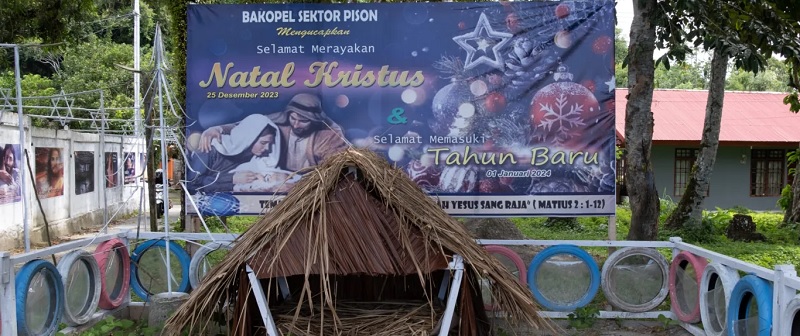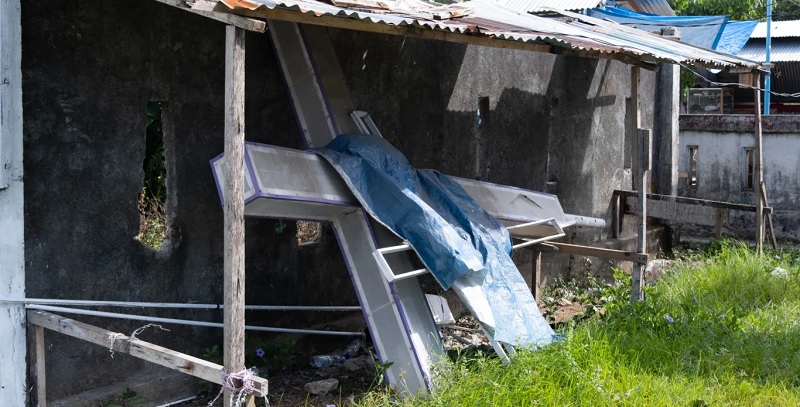
29 Feb Blog | Easter Gardens and Christmas trees
By Fridus Steijlen.
When I arrived in mid-January in Ambon for my second year at the Pattimura University I saw Christmas and New Year decor on the streets, which reminded me of the displays I saw the year before at the end of February. Small lighted string crosses were strung on poles along the road and on specific locations there were groups of three larger crosses. Purple was the dominant colour of the scarves and lights adorning many of the crosses. At many locations there were also caves with large stones at the entrance.
Later I came to know that the decor and displays that dotted the streets in Ambon were called Taman Paskah or Easter gardens. The crosses referred to the death of Jesus Christ and the cave that was his grave from which he resurrected. It turned out to be an important church activity. Christian colleagues at the University told me that church congregations would build their own Taman Paskah commemorating the death and resurrection of Jesus Christ. Sometimes competitions were held between congregations with the church council acting as jury. On the eve of Easter, people would walk to the church with torches and take part in joint activities until the early morning Easter service.
For Christians the weeks before Easter is a period of contemplation and especially for Roman Catholics the Lenten period is also for fasting. In 2023 the last weeks of this pre-Easter period coincided with the first weeks of Ramadan, the Muslim fasting month. The streets of Ambon then turned into a spectacle of religious ‘outlets’, especially at the end of the afternoon just before iftar, the breaking of the fast at dusk. Taman Paskah and lighted chain crosses alternated with busy stalls selling takjil, sweets and savouries for Iftar. This year in 2024 there will be a short overlap with the Muslim fasting month again.
There were also Christmas gardens last year, I was told. And indeed, this year I saw some Christmas displays. The displays were, compared to the Taman Paskah, less religious than I expected. There were many Christmas trees, some with small presents, and toy reindeer and Santa Clauses. Some of the Christmas trees consisted of twinkling lights that changed colours during the night. Along the streets, I saw small hanging stars, Christmas trees, and church bells. White lights during the day, colourful lights at night.

Christmas display, 2024. Photo: Fridus Steijlen.
Most of the symbols at the Christmas displays were secular, referring to commonplace Christmas decor. Only at some displays did I find an explicit reference to the story of the birth of Jesus Christ. In one village I saw a stable with a cradle, in another village I encountered an object that looked like a combination of the stable and cradle which Jesus was born in, with a large banner showing Mary and Joseph with baby Jesus. It was a ‘modern’ picture. Not Mary and Joseph kneeling devoutly beside the cradle but holding the child Jesus in their arms.
At another display, I saw a small construction that could be taken to represent a stable. But at the back of the display, up a small hill there was also a cave that was part of the Taman Paskah.
That cave was evidence that this was the same location as the Taman Paskah. At other places I had seen crosses ready for use as part of a display. At one location the crosses were lined up behind the bushes and there was a banner which read ‘Merry Christmas’ next to a huge Christmas tree. A bit further were one large and some smaller crosses resting under a shelter next to another Christmas tree. ‘These are from my congregation’ a woman told me. ‘We will put the cross where the tree is now.’
The ‘waiting crosses’, and the small cave in the hill were like set pieces waiting for a changement, a change of scenery in a theatre. In this case, it was the display of religious meanings in the public space. Which still left me with some questions such as why were the Taman Paskah more religious than the Christmas displays? and why not a display with baby Jesus in a cradle, accompanied by Mary and Joseph devoutly kneeling in a stable, as I used to see in public displays during my youth in the Catholic south of the Netherlands?

Waiting Crosses 2024. Photo: Fridus Steijlen.
It must have to do with the difference in the events, not only from a religious perspective but also from a social perspective. First of all, the absence of Mary, Jesus and Joseph in stables fits very well in the Protestant tradition. But there is more, as an old friend and colleague pointed out while discussing my observations. Christmas, combined with New Year has a larger social dimension than Easter. Families get together to enjoy food and celebrate the birth of Christ. Easter on the other hand has a more intrinsic religious meaning: Christ’s suffering, sacrifice and death to save mankind. And there is the promise of hope with his resurrection. His death and resurrection have more impact on humankind than his birth, and moreover the cross is a very strong symbol for worship.
Whatever the background and differences between the Easter and Christmas displays in the streets of Ambon may be, they keep on telling the story of important moments in the Christian faith, sometimes intertwined with those of their Muslim compatriots.
At the time of I writing this blog at the beginning of February, Easter is coming closer. At some places the changement is taking place: crosses are taking over public space.
Fridus Steijlen is visiting professor at Pattimura University, emeritus professor at VU Amsterdam, and honorary fellow at KITLV.




No Comments